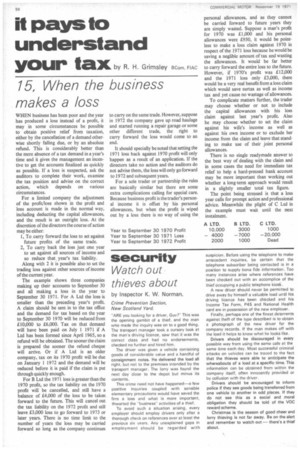it pays to understand
Page 56

If you've noticed an error in this article please click here to report it so we can fix it.
yourtax by R. H. Grimsley BCom, FIAC
15, When the business makes a loss
WHEN business has been poor and the year has produced a loss instead of a profit, it may in some circumstances be possible to obtain positive relief from taxation, either by the cancellation of a demand otherwise shortly falling due, or by an absolute refund. This is considerably better than the mere absence of a tax demand in a year's time and it gives the management an incentive to get the accounts finalized as quickly as possible. If a loss is suspected, ask the auditors to complete their work, examine the tax position and advise on the correct action, which depends on various circumstances.
For a limited company the adjustment of the profit/loss shown in the profit and loss account is made in the normal way, including deducting the capital allowances, and the result is an outright loss. At the discretion of the directors the course of action may be either: 1, To carry forward the loss to set against future profits of the same trade.
2, To carry back the loss just one year to set against all sources of income and so reduce that year's tax liability. Along with 2 it is possible also to set the trading loss against other sources of income of the current year.
The example shows three companies making up their accounts to September 30 and all making a loss in the year to September 30 1971. For A Ltd the loss is smaller than the preceding year's profit. A claim should be sent in to the tax office and the demand for tax based on the year to September 30 1970 will be reduced from £10,000 to £6,000. Tax on that demand will have been paid on July 1 1971 if A Ltd has been formed since April 1965, so a refund will be obtained. The sooner the claim is prepared the sooner the refund cheque will arrive. Or if A Ltd is an older company, tax on its 1970 profit will be due on January 1 1972 and the demand will be reduced before it is paid if the claim is put through quickly enough.
For B Ltd the 1971 loss is greater than the 1970 profit, so the tax liability on the 1970 profit will be cancelled, and still have a balance of £4,000 of the loss to be taken forward to the future. This will cancel out the tax liability on the 1972 profit and still leave £3,000 loss to go forward to 1973 or later years. There is no time limit to the number of years the loss may be carried forward so long as the company continues to carry on the same trade. However, suppose in 1972 the company gave up road haulage and started running a repair garage or some other different trade, the right to carry forward the loss would come to an end.
It should specially be noted that setting the 1971 loss back against 1970 profit will only happen as a result of an application. If the directors take no action and the auditors do not advise them, the loss will only go forward to 1972 and subsequent years.
For a sole trader or partnership the rules are basically similar but there are some extra complications calling for special care. Because business profit is the trader's personal income it is offset by his personal allowances, but when the profit is wiped out by a loss there is no way of using the Year to September 30 1970 Profit Year to September 30 1971 Loss Year to September 30 1972 Profit personal allowances, and as they cannot be carried forward to future years they are simply wasted. Suppose a man's profit for 1970 was £1,000 and his personal allowances were £950, it would be pointless to make a loss claim against 1970 in respect of the 1971 loss because he would be saving a neglible amount of tax and wasting the allowances. It would be far better to carry forward the entire loss to the future. However, if 1970's profit was £12,000 and the 1971 loss only £3,000, there would be a very real benefit from a loss claim which would save surtax as well as income tax and yet cause no wastage of allowances.
To complicate matters further, the trader may choose whether or not to include the capital allowances with his loss claim against last year's profit. Also he may choose whether to set the claim against his wife's income as well as against his own income or to exclude her income from the claim and leave that standing to make use of their joint personal allowances.
There is no single readymade answer to the best way of dealing with the claim and in some cases the need for immediate tax relief to help a hard-pressed bank account may be more important than working out whether a long-term approach would result in a slightly smaller total tax figure.
The point being stressed is that a loss year calls for prompt action and professional advice. Meanwhile the plight of C Ltd in the example must wait until the next instalment.
A LTD. B LTD. C LTD.
10,000 3000 1000 — 4000 —7000 —20,000 2000 1000 Dead




















































































































